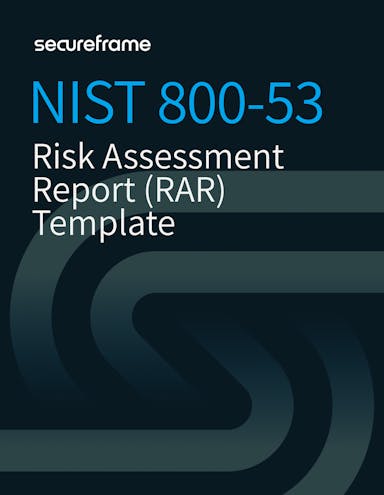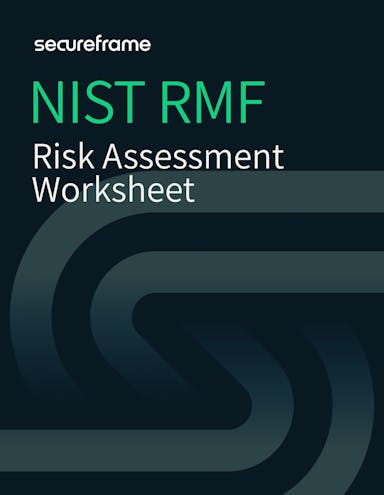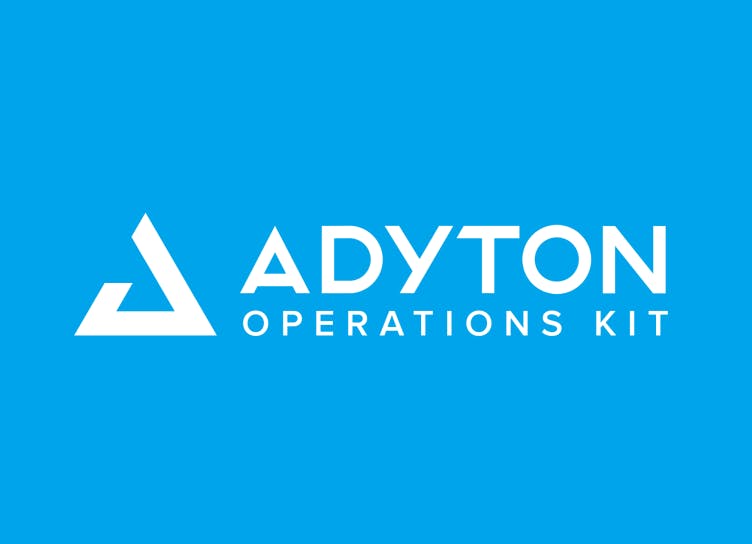Conducting a risk assessment is a critical step in achieving compliance with NIST SP 800-53. Not only does it help identify potential threats and their impact, it also ensures that the right controls are in place to protect your systems and information assets from unauthorized access.
But how do you conduct a risk assessment that’s fully compliant with NIST 800-53?
The Rev 5 document outlines specific requirements for risk assessments, while the NIST Risk Management Framework (RMF) provides more detailed guidance. Below, we'll explore these requirements, walk through the NIST RMF risk assessment process, and share practical templates to simplify your next risk assessment.
The NIST SP 800-53 risk assessment control family
While NIST 800-53 doesn’t prescribe an exact risk assessment process, it does set clear expectations for how organizations should approach risk assessments. The Risk Assessment (RA) control family outlines requirements for evaluating and managing security risks for each control baseline.
Let’s examine the key requirements within the RA control family that you need to be familiar with.
RA-1: Develop, document, and disseminate a risk assessment policy and procedures
The first step in a strong risk assessment process is creating a clear, well-defined policy and procedures. This policy should outline the risk assessment’s purpose, scope, and process, as well as align with any relevant laws, regulations, and standards.The procedures should detail the step-by-step actions required to complete the risk assessment effectively.
Assign a policy owner who is responsible for overseeing the development and implementation of both the policy and procedures, as well as communicating them across your organization. This person should also specify procedures that outline who conducts risk assessments, how often they occur, what methodologies are used, and how findings are documented and reported.
The policy owner is also responsible for regularly reviewing the policy and procedures and keeping them up-to-date as your organization’s risk landscape, business objectives, and compliance requirements evolve.
RA-2: Categorize the system and the information it processes
Categorizing your system’s information is a critical step in determining the right security measures. This means defining how sensitive the data you process, store, and transmit is. Getting this right is important because it shapes the security controls you’ll need to put in place.
Be sure to document each categorization decision, explain why it was made, and get formal approval from senior management. You’ll also need to revisit and update these categories throughout the system’s lifecycle to keep up with changing risks.
RA-3: Conduct a risk assessment
This is where the real work begins: identifying threats, vulnerabilities, and the potential impacts of various threats. A strong risk assessment process should cover five key areas:
- Identifying threats: Assess potential sources of risk, such as cyberattacks, insider threats, and natural disasters.
- Evaluating vulnerabilities: Pinpoint weaknesses in your systems, whether they stem from technical flaws, procedural gaps, or human error.
- Analyzing likelihood and impact: Assess how likely each threat is to exploit a vulnerability and what the consequences would be for your organization.
- Documenting results: Record your findings in a risk assessment report that includes a prioritized list of risks and recommended treatment.
- Reassessing regularly: Risk is constantly evolving. Keep your assessment up to date as new threats emerge, systems change, and vulnerabilities are addressed.
RA-5: Implement vulnerability scanning and monitoring
A solid vulnerability management process starts with defining who’s responsible for identifying, assessing, and fixing security gaps.
It’s also important to conduct regular vulnerability scans to catch gaps and misconfigurations before they become a bigger problem. Use automated tools to continuously scan your systems, analyze scan reports, and remediate identified issues based on your risk assessment findings. And since new threats pop up all the time, using tools that can adapt to the latest vulnerabilities will help you stay ahead and keep your defenses strong.
RA-6: Use technical surveillance countermeasures (Optional)
Technical Surveillance Countermeasures (TSCM) are all about staying one step ahead of covert threats. These methods help detect and neutralize eavesdropping devices, hidden surveillance tools, and other electronic spying techniques.
They’re especially critical for organizations handling highly sensitive or classified information, such as government agencies, defense contractors, and critical infrastructure providers where even a small security lapse could have serious consequences.
So how do you know if TSCM applies to your organization? First, if you work with classified information or operate in a high-risk environment, TSCM should be part of your risk management strategy. Also consider the sensitivity of the data you handle and whether your systems could be a target for espionage or advanced persistent threats.
RA-7: Risk response
Your risk assessment isn’t just an exercise, it should drive real action. The next step is putting risk responses into motion in a way that aligns with your organization’s risk tolerance. That means taking timely, strategic action to mitigate, transfer, accept, or avoid risks based on your findings.
Develop a clear plan that spells out exactly who is responsible for responding to identified risks, when mitigations need to be implemented, and how progress will be tracked through timelines and milestones.
RA-8: Conduct privacy impact assessments (Privacy baseline)
If your organization collects personally identifiable information (PII), conducting a Privacy Impact Assessment (PIA) is a critical step. This process helps you evaluate how personal data is collected, used, stored, shared, and protected, so you can identify and mitigate any potential privacy risks.
A PIA helps organizations understand the privacy implications of their data practices by analyzing factors such as data retention policies, access controls, third-party data sharing, and potential risks of unauthorized disclosure or misuse. It also assesses whether data collection aligns with regulatory requirements, organizational policies, and customer expectations.
RA-9: Perform a criticality analysis (Moderate and High baselines)
Pinpointing critical system components and functions is essential for prioritizing security efforts. By identifying what’s most crucial to your infrastructure, you can allocate resources effectively and focus protection where it matters most. This step ensures that business-critical operations remain resilient against potential threats, minimizing risk and maintaining continuity.
RA-10: Establish cyber threat hunting capabilities (Optional)
Proactive threat hunting gives you the upper hand against cyber threats by allowing you to detect, track, and eliminate risks before they disrupt your operations. Instead of waiting for alerts or reacting to incidents after they happen, this approach focuses on actively searching for hidden threats that may already be lurking in your environment.
To do this effectively, start by leveraging advanced threat detection tools that scan for indicators of compromise or suspicious activity that could signal a breach. These tools help uncover anomalies that traditional security measures might miss.
Next, establish clear processes for tracking and disrupting active threats so your team knows exactly how to respond. This means defining how threats are identified, analyzed, and neutralized before they escalate.
Finally, invest in ongoing training for your cybersecurity teams. Threat actors are constantly evolving their tactics, so keeping your team up to date on modern threat hunting techniques is crucial. Regular training helps security professionals sharpen their ability to detect subtle threats, analyze attack patterns, and take action quickly.
How to use the NIST Risk Management Framework and NIST Cybersecurity Framework to complete a NIST 800-53 risk assessment
Because the NIST 800-53 Rev 5 document doesn’t define a specific risk assessment process, most organizations turn to the NIST Risk Management Framework (RMF) and NIST Cybersecurity Framework (CSF) 2.0 for guidance on conducting risk assessments and managing security risks effectively.
The NIST CSF 2.0 provides a high-level, flexible framework designed to help organizations of all sizes improve their cybersecurity posture. It expands on the original framework’s five core functions (Identify, Protect, Detect, Respond, and Recover) by adding a new Govern function, which emphasizes the importance of risk management strategy, roles, and responsibilities. This addition makes CSF 2.0 even more effective for integrating risk assessment into an organization’s overall security program.
When performing a NIST 800-53 risk assessment, organizations can use NIST CSF 2.0 to:
- Identify and prioritize risks by aligning security controls with business objectives
- Map NIST 800-53 controls to CSF categories to assess any security gaps
- Implement a risk-based approach to control selection and monitoring
- Continuously improve operational resilience with the CSF’s iterative approach to risk management
While NIST CSF 2.0 providence a high-level roadmap for cybersecurity and risk assessment, organizations managing regulated data often use the NIST RMF to implement and assess security controls in detail. Outlined in NIST Special Publication 800-37 Rev. 2, “Risk Management Framework for Information Systems and Organizations: A System Life Cycle Approach for Security and Privacy,”, the RMF guides organizations through preparing, categorizing, selecting, implementing, assessing, authorizing, and monitoring security controls, making it a more formal and structured approach to risk management.
So how do they work together? The CSF 2.0 provides the what: a broad roadmap for cybersecurity improvements. The RMF delivers the how: a detailed process for implementing security controls and managing risk. Many organizations use the CSF to identify gaps and set priorities, then turn to the RMF to execute specific security measures, particularly those tied to NIST 800-53 controls.
By using NIST CSF 2.0 to establish a risk management strategy and NIST 800-53 as a control framework, organizations can create a comprehensive, adaptable approach to cybersecurity that aligns with both business objectives and regulatory requirements.
Next, let’s dive into how the RMF provides specific guidance on conducting risk assessments.

Step 1: Categorize information systems
The first step in the RMF process is categorizing your system based on the type of information it processes and the potential impact of a security breach. This means assessing the sensitivity and criticality of your data and determining its confidentiality, integrity, and availability (CIA) requirements.
To assign an appropriate impact level (Low, Moderate, or High), use standardized tools like FIPS 199 and NIST SP 800-60. These resources help define the potential consequences of a compromise, ensuring that security controls match the system’s risk level. Once categorization decisions are made, they should be documented in the System Security Plan (SSP) and formally reviewed and approved by senior leaders and key stakeholders.
This step is where risk assessment truly begins. Categorization sets the scope for your risk analysis by identifying what’s critical and where the greatest risks lie.
Step 2: Identify threats and vulnerabilities
The RMF stresses the importance of understanding potential threats, whether they come from external sources like cyberattacks or internal risks such as insider threats. Organizations are expected to gather intelligence on the risks their systems face, focusing on two key areas:
- Threats: External or internal factors that could exploit weaknesses, such as cyberattacks, insider threats, or natural disasters.
- Vulnerabilities: Weaknesses in your system that threats could exploit, including unpatched software, misconfigurations, or weak access controls.
To get a clear picture of your risk landscape, you’ll need to collect and analyze data from vulnerability scanners, threat intelligence feeds, and penetration test reports. This proactive approach ensures that risks are identified, assessed, and addressed before they can be exploited.
Step 3: Analyze risk likelihood and impact
This is the core of risk assessment, where organizations evaluate each identified threat and vulnerability to determine its potential impact. This involves two key factors:
- Likelihood: How probable is it that this risk will materialize? Consider factors like threat actor capabilities, existing security measures, and historical attack trends.
- Impact: What are the consequences if the risk occurs? This ties back to the system’s impact levels established during categorization.
By quantifying risk, organizations can prioritize their risk response. Some use qualitative scales (e.g., High, Medium, Low) for simplicity, while others apply quantitative methods, such as assigning dollar values or probability scores to assess financial or operational impact. A structured approach to risk analysis ensures that security efforts focus on what matters most.
Recommended reading

Risk Analysis Calculations: 7 Ways to Determine Cybersecurity Risk Scores
Read MoreStep 4: Assign risk levels and prioritize risks
After analyzing likelihood and impact, the next step is to assign an overall risk level to each identified issue. This is typically visualized in a risk matrix to help prioritize risks based on severity. For example, high likelihood + high impact = critical risk, while low likelihood + low impact = minimal risk.
In some cases, a risk exception may be identified, meaning a risk exists but won’t be fully mitigated. Instead, the organization documents the decision to accept the risk and provides justification.
Risk exceptions in NIST 800-53 can arise from:
- Residual risks: Leftover risk after implementing the appropriate security controls (i.e., a risk that’s been mitigated to an acceptable level, but not completely resolved).
- Low-impact risks: Risks with minimal likelihood and impact that don’t justify the cost of mitigation.
- Operational constraints: Risks that cannot be mitigated due to technological or operational limitations.
- Cost vs. benefit: When mitigation costs are higher than the potential impact of the risk.
- Temporary allowances: Risks that can’t be immediately addressed but are accepted temporarily with a plan for future mitigation.
Risks that won’t be mitigated must be formally documented in the Risk Assessment Report (RAR) or the Plan of Action and Milestones (POA&M). The documentation should include the reason the risk cannot or will not be mitigated, any supporting evidence such as a cost analysis, and formal approval from an Authorizing Official.
Step 5: Document risks
Once your initial assessment is complete, it’s time to compile your findings into a risk assessment report or register. This document is not only vital for internal use but also serves as evidence of your compliance efforts during audits.
A risk assessment report or register is essentially the culmination of your entire risk assessment process—it’s where all your findings, analysis, and recommendations are documented. Think of it as a roadmap that helps your organization understand the risks it faces, their potential impact, and what you need to do to address them. For NIST 800-53 compliance, this document shows that you’ve taken the time to identify threats, assess vulnerabilities, and prioritize actions to protect your systems and data.
The purpose of the report/register goes beyond just checking a compliance box. It’s there to inform decision-making across your organization. For example, leadership can use it to allocate resources to the highest-priority risks, IT teams can use it to plan and implement technical controls, and compliance officers can rely on it during audits to demonstrate due diligence.
Within your organization, you can use the risk assessment report/register as a living document. It’s not something you file away and forget about—it’s a tool that helps you monitor and manage risks over time. As your systems or threat landscape change, you’ll revisit the report to update it with new findings and ensure your mitigation strategies are still effective. It’s also a great way to create accountability, as the report clearly defines the roles and responsibilities for addressing each identified risk.
For NIST 800-53 compliance specifically, the risk assessment report or register is essential because it ties directly to control selection. It helps you justify why certain controls are in place and ensures they align with the risks you’ve identified. Without a well-documented report, it’s nearly impossible to prove you’ve followed the framework’s requirements or implemented appropriate safeguards. In short, it’s both your compliance safety net and your guide to staying secure.

NIST 800-53 Risk Assessment Report (RAR) Template
Download our NIST 800-53 Risk Assessment Report Template to streamline the process of documenting your risk assessment and ensure you’re meeting key security and compliance requirements.
Step 6: Integrate findings into your overall risk management strategy
The risks identified and analyzed during this phase aren’t handled in isolation. They need to be integrated into the broader risk management strategy, which guides how your organization will address, mitigate, or accept risks. This also feeds into the next step: selecting and tailoring the appropriate controls from the NIST SP 800-53 catalog.

NIST RMF Risk Assessment Worksheet
Our risk assessment worksheet walks you through each phase of conducting a risk assessment for NIST 800-53, providing guidance, examples, and key considerations at each step.
How to use your risk assessment to select and implement NIST 800-53 controls
Now that you’ve identified and prioritized risks, you have a clear understanding of your organization’s risk landscape. The next step is to turn that insight into action by selecting and implementing NIST 800-53 controls that will protect your systems and assets from those threats.
By mapping the right controls to your specific risks, you can build a stronger security posture and ensure compliance while addressing the most pressing vulnerabilities.
1. Start with risk assessment results
Your risk assessment lays the groundwork for choosing the right security controls. It helps you understand what’s at stake and where to focus your efforts by clearly identifying:
- Your system’s impact level and the baseline NIST 800-53 controls that apply.
- Potential threats that could compromise your systems and data.
- Vulnerabilities that attackers could exploit.
- How likely each vulnerability is to be exploited and what impact it would have.
- Which risks should be tackled first based on severity.
With this information in hand, you can prioritize what needs the most protection and ensure you're implementing the right baseline controls to meet NIST 800-53 requirements without wasting time or resources on unnecessary safeguards.
2. Tailor the baseline controls
To ensure your security measures align with your organization’s unique risk landscape, customize your baseline controls based on the specific threats and requirements identified in your risk assessment. This may involve adding, removing, or modifying controls to ensure they effectively mitigate identified risks.
If your risk assessment reveals gaps in baseline controls where certain threats aren’t fully addressed, you’ll need to add new controls or enhance existing ones. If a baseline control doesn’t apply to your system’s architecture or functionality, you may be able to remove it. In some cases, rather than adding or removing controls, you may need to adjust how they are implemented to better fit your security environment.
For example, if your risk assessment highlights a specific vulnerability in user authentication, you might enhance the baseline control for access management by implementing multifactor authentication. Or if third-party vendors present significant risks, you might add or modify controls to improve supply chain risk management, such as periodic vendor security assessments or specifying security requirements in vendor contracts.
4. Align with your organization’s risk tolerance
Your organization's risk tolerance is a key factor in selecting the right security controls. Some risks may be acceptable with minimal safeguards, while others require stronger, layered protections. This also ensures that resources are allocated efficiently, prioritizing critical risks while avoiding unnecessary complexity for lower-priority threats.
Recommended reading

How to Define Your Organization’s Risk Appetite in 8 Steps
Read More5. Map selected controls to identified risks
Every risk identified in your risk assessment should be mapped to one or more security measures from the NIST 800-53 control catalog and documented in a System Security Plan (SSP). The SSP serves as a central record that explains how each control is implemented, which risk it mitigates, and whether it is fully operational.
Mapping risks to controls provides a clear, structured approach to security, ensuring that every identified threat has a corresponding mitigation strategy. This document also plays a key role in compliance audits and reviews, allowing auditors and stakeholders to quickly understand how your organization is addressing specific risks. Auditors and authorizing officials will closely review the SSP to ensure your system complies with NIST 800-53 and organizational requirements.
6. Assess and monitor control performance
If your assessment uncovers weaknesses, gaps, or noncompliance with NIST 800-53 controls, you’ll need to document them in your Plan of Actions and Milestones (POA&M). Think of the POA&M as a to-do list for security improvements: it tracks what needs to be fixed, who's responsible, and when it should be resolved.
Once you move into the Monitor step, the POA&M becomes a living document that evolves over time. Any new risks or weaknesses discovered during assessments are added to the POA&M, and completed actions are updated and closed out. Progress is reviewed regularly to ensure security gaps are addressed on time and your security posture is always improving.
Leverage the power of compliance automation
Achieving and maintaining NIST 800-53 compliance is no small feat. With hundreds of security and privacy controls, extensive documentation requirements, and the need for ongoing risk assessments, the process can quickly become overwhelming — especially if you're managing it all manually.
By leveraging compliance automation platforms, organizations can streamline risk assessments, control implementation, and continuous monitoring, reducing the burden on security teams while ensuring ongoing compliance.
Here’s how Secureframe and compliance automation makes NIST 800-53 compliance more efficient and effective:
- Control mapping: Instead of manually sorting through controls, Secureframe integrates with your systems to align risk assessment framework requirements with your existing risk related controls, identify compliance gaps, and map common controls across dozens of regulatory and security risk assessment standards to simplify multi-framework compliance.
- Automated risk assessments: Conducting risk assessments manually can be tedious and prone to human error. Secureframe’s AI-powered risk assessment workflows help identify risks, suggest appropriate controls, and calculate residual risk, ensuring an efficient and repeatable process.
- Centralized control tracking and document management: Rather than juggling spreadsheets and emails, automation platforms create a single source of truth for all of your compliance efforts. This makes it easy to track control implementation, effectiveness, and audit readiness in real time.
- Continuous control monitoring: Secureframe’s deep integrations continuously monitor your security controls to detect non-compliance issues and alert teams to potential vulnerabilities, allowing you to stay ahead of issues before they become major compliance failures.
- Streamlined reporting and audit readiness: Preparing for audits can take months when documentation is scattered. Automation allows you to generate real-time compliance reports and automatically map evidence to controls so you can clearly demonstrate compliance during audits.
Learn more about how Secureframe helps companies reduce manual effort, minimize human error, and maintain continuous compliance without slowing down operations.
Recommended reading

Adyton Streamlines NIST 800-53 Compliance, Resulting in 50-70% Time Savings with Secureframe
Read More